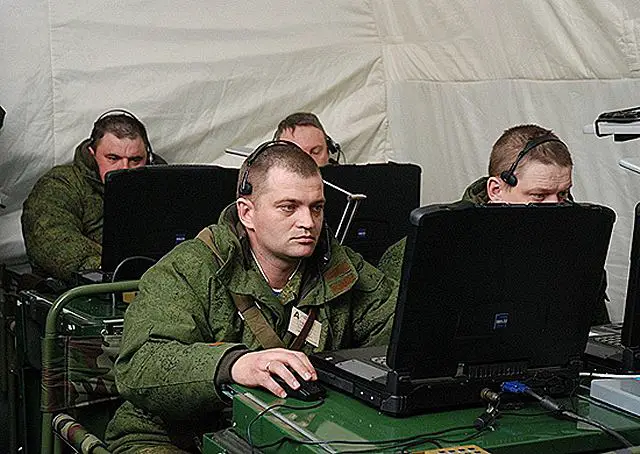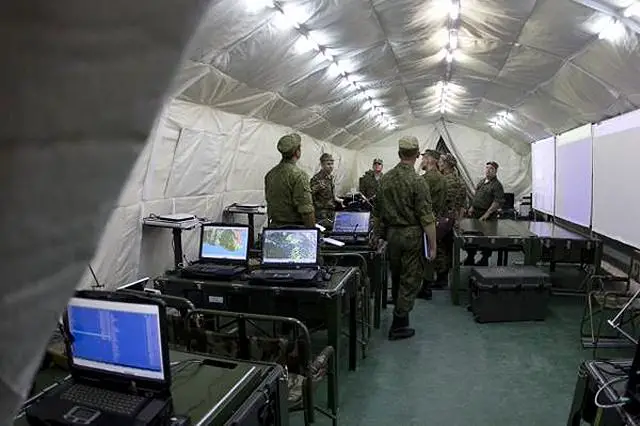Russian airborne troops have received new video communication software TASS 12501171
|
|
|||
|
Military Defense Industry Technology - Video communication
|
|||
|
|
|||
| Russian airborne troops have received new video communication software. | |||
|
The Russian Army Airborne Force has received a new video communications software program allowing video communications between individual troops and secure teleconferences of dozens of subscribers separated by thousands of kilometers, according to the Izvestia daily newspaper.
|
|||
|
|
|||
 Russian airborne soldiers train with new communication systems Russian airborne soldiers train with new communication systems |
|||
|
|
|||
|
The advanced program from Sozvezdiye Corp. in Voronezh passed its tests during Exercise Caucasus 2016 and has been integrated with the Andromeda-D automated command and control system, along with which it has been fielding to Airborne on a large scale, a Defense Ministry official close to the matter told the Izvestia daily. During the exercise, troops would establish and maintain stable comms among several regimental and division HQs, using the latest program and, thus, speeding up the work of the commanders and their staffs.
The new software program is installed on organic laptops and tablets of the officers from deputy battalion commander on. In real life, even company commanders and platoon and squad leaders would use video comms, when necessary, the officer told the Izvestia daily. At present, the program is used not only on mission but in everyday activities as well. In particular, videoconferences are held instead of having commissioned officers attend meetings in person. According to the Izvestia daily, the new program was developed in Russia. It operates in the Astro-Limux operating system from RusBITekh specifically for the Russian military. Its tests within the framework of the Andromeda-D started in 2012. Airborne holds videoconferences, using only military satcom and relay systems with a speed of 1.5-2.5Mbps. Depending on the whereabouts of the subscribers, the most convenient type of connection is selected. Satellites provide very good coverage, but their throughout is just above 1.5Mbps. Relay stations feature up to 2.5Mbps or more, but the situation is not always conducive to deploying several consecutive relays to establish a link from one subscriber to another. The program will not work on public communications networks. |
|||
|
|
|||
 Russian soldiers perform exercise with Andromeda-D automated command and control system. Russian soldiers perform exercise with Andromeda-D automated command and control system. |
|||
|
|
|||
|
"For instance, a channel with about 3.5Mbps is required for watching 720dpi- resolution movies on the Internet," expert Sergei Kravtsov tells the Izvestia daily. "The 1.5-2.5Mbps speed at the military’s disposal will afford it the stable non-fuzzy image. The program is no online cinema, but a command and control app, and, therefore, it will work only on secure networks where it cannot be hacked. Therefore, sticking to military-only networks is makes sense all right."
The United States is the world’s leader in military video communications gear development. In particular, the US invasion of Afghanistan in 2001 became the first military operation planned only through videoconferencing. The Pentagon succeeded in coordinating the efforts of several HQs running the operation from military bases in Florida, Kazakhstan and Uzbekistan and on Masirah Island vic. Oman. However, at the time, the US DoD had to rent commercial channels and use commercial off-the-shelf software. During Operation Iraqi Freedom in 2003, US Special Forces groups deployed companies outfitted with satcom and radio relay gear and being responsible for videoconferencing alone, and the first military videoconferencing program, VCR, was developed. Now, each US armed service has video information transmission software of its own. The Russian Defense Ministry is intent on developing secure videoconferencing equipment for its forces too. The Russian Paras are the first to have received a videoconference messenger of their own, according to the Izvestia daily. |
|||
|
|
|||
|
© Copyright 2017 TASS. All rights reserved. This material may not be published, broadcast, rewritten or redistributed.
|
|||




























